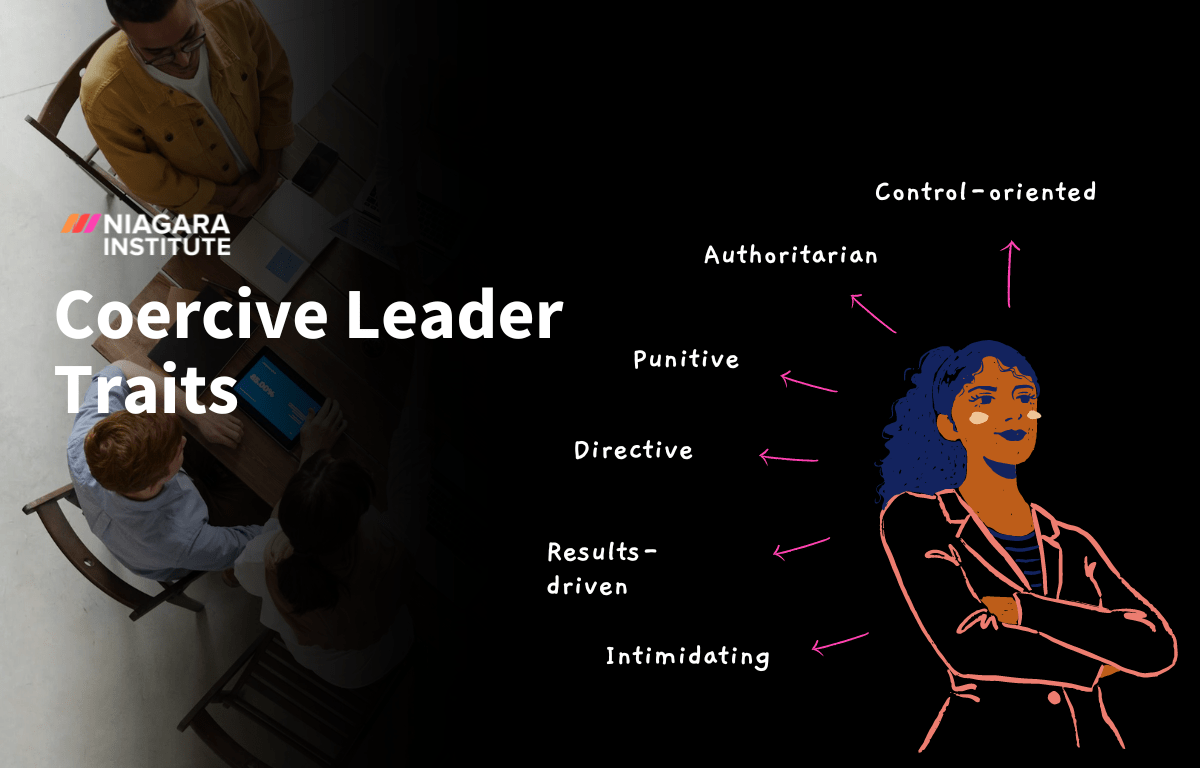10 min read
What Is Referent Power In Leadership? Definition, Examples, and Quiz
Have you ever noticed how some leaders just have that magnetic pull?
3 min read
 Gavin Brown
:
Apr 17, 2024 11:20:18 AM
Gavin Brown
:
Apr 17, 2024 11:20:18 AM

Your manager storms into a meeting, slams down a stack of papers, and declares that anyone who misses the new deadline will face immediate consequences. The room falls silent. While this might seem like decisive leadership, you've just witnessed coercive leadership in action - a style that relies on fear, punishment, and control rather than inspiration or collaboration
Coercive leadership represents one of the most controversial leadership approaches in modern working environments.
Unlike other power structures that build on trust and mutual respect, coercive leaders wield authority through threats, penalties, and the promise of negative consequences.
Coercive leadership is a management style where leaders use their position of authority to compel compliance through fear, punishment, or the threat of negative consequences. This approach relies heavily on legal authority and formal power structures to maintain control over team members and organizational outcomes.
At its core, the coercive leadership style operates on a simple premise: "Do what I say, or face the consequences."
Coercive leaders typically use their hierarchical position to impose their will, often disregarding input from team members or alternative perspectives. This creates a top-down command structure where questioning authority is discouraged or penalized.
The term "coercive" originates from the Latin word "coercere," meaning "to restrain" or "to confine." In leadership contexts, this translates to restricting employee autonomy and decision-making freedom. Unlike reward power, which motivates through positive incentives, coercive power operates through negative reinforcement and punishment-based motivation.
In leadership, coercive power is the ability of a leader to get people to do what they want by threatening them with negative consequences.
It is often contrasted with other forms of power, such as reward power, legitimate power, expert power, and referent power, which are based on positive incentives, formal authority, specialised knowledge, and personal attractiveness or charisma, respectively.
Like autocratic leadership style, a coercive leader often uses strict rules and consequences to control behavior among team members. However, too much coercive power can lead to a negative and stressful work environment, often resulting in a toxic boss scenario where employees feel constantly threatened, demoralized, and demotivated.
Coercive leaders show distinct behavioral patterns that set them apart from other leadership styles. These characteristics often manifest in ways that create tense working environments and can contribute to the development of a toxic boss dynamic.
Coercive leaders rarely seek input from team members when making decisions. They believe their position grants them the right to make unilateral choices, often dismissing alternative viewpoints or creative solutions from subordinates. This approach can stifle innovation and reduce team engagement.
Rather than inspiring excellence through positive reinforcement, coercive leaders rely on threats and penalties to drive performance. They may use tactics like public criticism, job security threats, or withholding opportunities to maintain control over their teams.
These leaders often struggle to delegate effectively, preferring to maintain tight control over every aspect of their team's work. This behavior stems from a fundamental distrust of others' abilities and a need to maintain absolute authority.
Coercive leaders frequently display poor emotional intelligence and limited empathy. They may struggle to understand how their behavior affects team morale and often prioritize immediate compliance over long-term relationship building.
When operating under coercive control, leaders typically resist constructive criticism or suggestions for improvement. They may view feedback as challenges to their authority rather than opportunities for growth.

In certain situations, coercive leaders can use their position, formal authority, and role in the company to achieve desired outcomes.
For instance, a sales manager can use coercive power for performance empowerment. He/she can warn underperforming sales staff about demotion or termination if they do not meet their sales targets within a specified period.
Or, for crisis management, people leaders can use a coercive approach in the workplace to control the situation. For example, he/she can demand immediate action to command the team.
A leader can use a coercive management style where immediate compliance is necessary, such as in crisis management or when safety is at risk.
Examples of leaders who have been described as coercive include Steve Jobs, Elon Musk, Jack Welch, and Martha Stewart.
We should note that there is a difference between boss and leader: a boss uses formal authority, while leaders create an environment where they balance authority and empathy, mix leadership styles, and don’t need to resort to any tactics to get people to follow them.
Though in some situations using coercive tactics are favorable, it's important to note that while these coercive approaches often came with substantial costs, including high turnover rates, damaged relationships, and negative impacts on organizational culture.
For example, coercive leadership often undermines self-leadership among employees, as it discourages autonomy and self-driven decision-making.
The excessive use of coercive power can also decrease the team happiness. This can lead to high turnover rates as employees may leave the organisation in search of a more positive work environment.
When a coercive leader uses threats or punishment, employees can become unhappy and stressed. Also, coercive leadership can lead to a toxic work environment, where it may discourage employees to stand up for themselves.
Modern leadership skills development emphasizes more collaborative and emotionally intelligent approaches.
Having and exercising coercive power is not inherently bad; however, it should be balanced to achieve positive and desired outcomes. Balancing coercive power with other forms of influence can lead to more positive outcomes and a healthier work environment.
If you find yourself frequently using coercive power in your leadership role, it may be time to reflect on your management style and consider improving your leadership skills.
Discover your leadership style by taking this quiz, and learn how to refine and enhance your management techniques based on your results.

10 min read
Have you ever noticed how some leaders just have that magnetic pull?

4 min read
In the organizational context, reward power is one of the key types of power that leaders and managers can use to influence and motivate their team...

5 min read
Every leader wields power, but not all power looks the same. The way you influence your team, drive decisions, and create change depends on which...